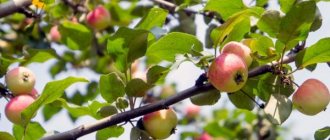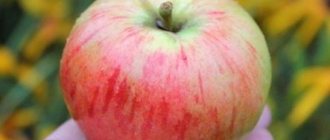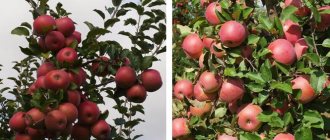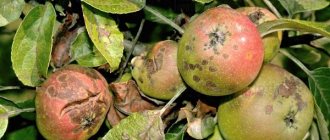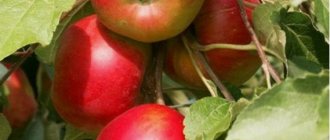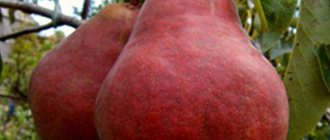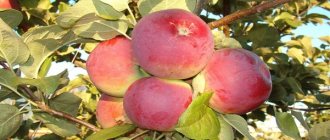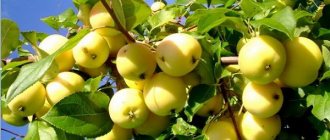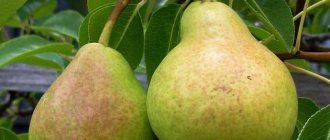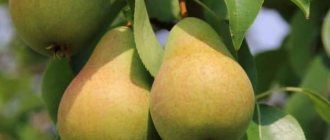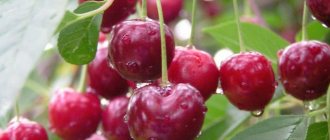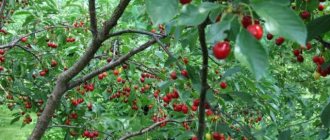Description and characteristics
An apple tree of medium height with a wide crown. It can bear fruit quite abundantly, the fruits are not large and do not stick well to the tree.
Description of the tree and fruits
The tree is not tall, about 3 meters in height. The hemispherical crown is quite dense, with thick shoots and a large number of bright green leaves. The apple tree grows moderately.
The fruits are medium-sized, sometimes even large, and pleasant to the taste. Their color is red with a burgundy tint and white dots in places. The skin is hard and shiny, the flesh is dense, juicy, sweet with sourness. The shape is regular, in the form of a truncated cone.
Pollination, fruiting and ripening period
The variety can be called self-pollinating. In the absence of neighbors, the fruits will set themselves. But the tree blooms profusely, so it is an excellent pollinator for other varieties.
Ripe apple fruits.
Harvesting in warm regions can be carried out in August, its second half. And in more northern regions this happens in September. It is very important to collect fruits in a timely manner, because they do not stick well to the branches. You can tell that they are ripe quite easily: the red-burgundy color of the skin begins to lighten.
Productivity of the variety
Productivity is considered average. In a normal year, you can harvest about 80 kg of fruit from one Richard apple tree.
Winter hardiness
In generally accepted terms, the variety can be called medium-resistant. The apple tree prefers to grow in warm and long summer conditions. A temperature of -28 degrees is critical.
Variety resistance to diseases and pests
All pests of apple trees can also settle on a tree of the Richard variety. Therefore, preventive spring spraying should always be carried out.
The variety has quite impressive immunity, but only under favorable circumstances. But in rainy conditions, scab and other fungi periodically appear.
Scab on an apple tree.
Advantages and disadvantages
It is worth listing in more detail a number of positive properties that the variety has. Among them:
- stable and moderate harvest;
- decent shelf life;
- the possibility of using the variety as a pollinator;
- taste and commercial qualities of fruits.
The disadvantage is that winter hardiness is not as high as we would like. Due to recurrent frosts, young shoots often suffer, and even cracks or frost holes may appear on large branches in cold winter conditions.
Characteristics and features of growing the Richard apple tree
Apples are the most common fruit in our country.
In Russia, a special love for apples is due to the ability to easily grow a large harvest of ripe fruits, as well as preserve them for a long time. Apple fruits are not only consumed fresh, but also serve as raw materials in cooking in the preparation of a variety of dishes and fortified drinks. Apples contain all the beneficial substances that have a beneficial effect on the human body, regardless of age.
Features of the variety
The Richard apple tree is grown quite rarely by domestic amateur gardeners. A description of this variety is not easy to find. According to some reports, the variety appeared by chance and was found two centuries ago in the territory of Kerkhow near Wittenburg in Germany. Judging by other historical sources, the variety did not have a random origin, but was bred in Kerkhove through the efforts of Pastor Kliphot.
In Russia, seedlings of this variety are known as “Richard Yellow”. The variety of apple trees "Richard" is a favorite among gardeners in East Prussia. In addition, this particular variety is common for cultivation on an industrial scale in Germany.
The advantages of the variety are represented by good taste, long shelf life of fruits, and high resistance to diseases.
Description of the variety
Fruit trees of this variety have moderate growth vigor and frost resistance. The crown on the tree is translucent, high and spherical. Fruit plantings of the "Richard" variety are quite demanding in terms of cultivation conditions. The plant needs heavy, slightly damp soil and moist air. In addition, the place where seedlings are planted should be protected as much as possible from gusts of wind. Cultivation of the variety using light and dry soil is allowed only if there is an artificial irrigation system.
The trees begin to bear fruit quite late and produce a moderate harvest. The flowering period is medium early, quite long. The apples are graceful, symmetrically built, and of medium size. Quite often there are large-sized fruits with slight ribbing, which is formed on one edge. The shape can be defined as truncated conical. The fruits are characterized by single-caliber.
Apples on trees do not hold very firmly, which is especially noticeable in the autumn. As the botanical stage of ripeness approaches, the fruits easily fall off at the slightest gust of wind. The stalks are thick and short, not protruding beyond the deep funnel. The skin of the fruit is slightly aromatic, smooth, very thin and has a pale yellow color. On sunny days, the fruits may acquire a slight blush. The seed material is quite small.
In unfavorable weather conditions, significant damage to plants by scab is observed.
How to plant an apple tree (video)
Chemical composition and application
The pulp of the fruit is yellowish in color, quite tender and juicy. The taste is characterized as sweet with a slight spicy aftertaste and slight sourness. The fruits contain a sufficient amount of vitamin C as well as antioxidants.
The fiber contained in apples can stimulate intestinal motility and reduce the risk of cancer. In addition, ripe fruits are good for the prevention of diseases of the cardiovascular system, for weight loss and for reducing cholesterol levels.
Rules for planting and care
Growing an apple tree of this variety requires experience in gardening. It is very important to correctly determine the landing site. The plant is very demanding of soil and may die in dry summers or in conditions of depleted soil.
Features and rules of landing
There are several requirements that relate to planting crops. There are few of them, and they are very simple, but they require execution.
Favorable conditions
In order for the Richard apple tree to develop normally, it needs to provide certain conditions on the site:
- The place should be sunny and protected from strong winds.
- The soil must be fertile and non-acidic.
- The distance to groundwater is at least 1.5 meters and drainage is required.
- Between the trees on the site there is a distance of 7 meters to the next one. But if there are fruit bushes nearby, then this figure can be reduced to 5 meters.
The process of planting an apple tree.
If these conditions are met, the apple tree will feel comfortable.
Planting steps and instructions
Planting is carried out according to an algorithm familiar to gardeners. Prepared and fertilized loose soil should be as moist as possible. In a pre-prepared hole you need:
- install drainage;
- make a mound of nutrient soil;
- install a peg that will serve as a support;
- place the seedling, straightening the roots;
- sprinkle with soil and water;
- mulch the tree trunk circle.
When planting, you need to make sure that the neck of the root is not buried in the ground. In a few weeks the soil will settle and more will need to be added.
Productivity of the variety
Richard apples ripen quite smoothly. The harvest period is set for the first half of September. Due to the fact that the fruits easily end up under the tree from any breeze, it is recommended not to delay the period of fruit harvesting.
In regions located in the southern regions of Russia, it is advisable to begin harvesting activities in mid-August. To be on the safe side, you can look at the shades of the apple peel. If it has lightened and slightly yellowed, this is a good signal to start picking apples.
The crop is placed in the optimal storage location. If the rules for providing the necessary conditions for the fruit are strictly followed, the fruits can easily be preserved until November.
Features of care
Caring for the variety includes standard procedures, starting with spring spraying, including fertilizers, pruning and removal of debris in the tree trunk circle.
Watering
In conditions of a fairly warm summer with normal precipitation, the fruit crop will need to be watered 3-4 times per season. It is better to make a small groove in the tree trunk circle so that moisture is not wasted. The first time watering is carried out during the flowering period, then after the ovaries and in the fall, before frost. An adult apple tree needs about 5 buckets of water, and a young apple tree needs 3 buckets.
Watering the apple tree.
Pruning and crown formation
Two procedures - sanitary pruning and crown formation can and should be combined. Pruning is carried out from the first year of life. First, they make a frame, forming skeletal shoots. After this, it will be necessary to remove only weak, damaged and inward-growing branches.
Fertilizer
Feeding is carried out several times during the season. Most often, fertilizers are applied at the root, diluted with water. In the spring, the procedure is carried out twice. The first time is immediately after the apple tree wakes up. You will need a solution of organic matter, mullein or urea. The second time is when the fruits are formed. Potassium and phosphorus are used for this. These fertilizing can be carried out on the leaf or in the ground. In the fall, organic matter is added to the tree trunk to feed the apple tree.
Apple tree fertilizer.
Apple tree Renet champagne: description and characteristics of the variety + photo
Choosing one variety or another is, at first glance, a simple matter. But when you touch this issue personally, then in reality not everything is as simple as it seems.
At the present stage of human development, breeders around the world have developed quite a lot of varieties of apple trees.
In addition to apple trees with normal characteristics, dwarf and columnar apple trees have also been bred. Each of which has its own care features and characteristics.
And in order to choose the right variety, you must first read the description of apple tree varieties , only then make a choice of one or another apple tree:
- First of all, you need to pay attention to the winter hardiness of the tree . Since it is winter hardiness that plays an important role not only for successful overwintering, but also for the formation and ripening of a good harvest;
- An important characteristic of the apple tree is also resistance to diseases and pests. If the tree is planted in an unsuitable climate, such as too wet or cold, the apple tree may become susceptible to pests and diseases.
Thus, the tree will simply not have time to recover after wintering or illness, and one can forget about a good harvest;
- the yield of the variety as equally important . For many gardeners and hobbyists, this indicator is the main one when choosing a variety;
- The taste of the fruit is also considered one of the main criteria. Moreover, recently there are many varieties of apples with a universal purpose. Those. these are the fruits that can be used not only for fresh consumption, but also for making jam, marmalade, and dried fruits;
- You also need to download about the shelf life of fruits . The choice of variety will also depend on the shelf life of the fruit. Using this indicator, you can predict your reserves for the winter period. After all, some apples can be stored until the next season.
Description, photo of the Champagne variety
The Champagne apple tree is one of the best large-fruited varieties . The apples are quite large. The maximum weight can reach 120 -140 grams.
The average fruit weight is 100 grams . Apples with a round and sometimes conical shape. The color is yellow, red shades in the form of streaks are often observed. The pulp is juicy and white.
It has a sweet and sour aftertaste.
Apples ripen at the end of September and do not have a long storage period. If all storage requirements are met, they can last approximately 25 to 30 days.
The tree has high winter hardiness . But it can often be damaged by bright direct sunlight.
Champagne yields are good and annual.
Apple tree “Richard” (winter variety, late ripening) 1 piece per pack
Best pollinators:
Jonathan or Idared. Apple tree "Richard"
– the fruits are large, weighing 180-220g, truncated-conical in shape with ribs in the toe area, intensely dark red in color, occupying most of the fruit. The pulp is creamy, very juicy and crispy, sweet taste with a slight note of sourness.
The tree is medium-sized, forms a compact rounded crown of hanging branches. It enters the fruiting period in 4-5 years; it is a very productive variety and does not have a tendency to bear fruit periodically. The plant is medium-winter-hardy, resistant to scab and relatively resistant to other diseases and various pests.
The fruits ripen by the beginning of October and can be stored until April in cold rooms; they have a universal, very wide purpose.
Advantages of the variety
- high yield
- long period of storage of fruits
- good pollinator
- early fruitfulness, productivity, marketability and keeping quality of fruits
- high transportability
The benefits of fruits for the human body
Apples are exceptional fruits that people consume almost all year round. Due to the content of a lot of vitamins and minerals, nutritionists call them the “fruit of health.”
For example, the presence of a large amount of iron, which is easily absorbed by humans, allows the fruit to be used in the fight against anemia, potassium helps stabilize the heart, and calcium strengthens bones.
It should be borne in mind that most of the vitamins and microelements are contained in the peel of the fruit, so there is no need to peel it before use.
Interesting facts about apples
Apple trees were the first cultivated trees. On the territory of Kazakhstan, you can find the Sievers apple tree in the wild - the ancestor of all domestic varieties. Nowadays, apple orchards occupy an area of about 5 million hectares on all continents. An apple tree planted in 1647 is still growing and bearing fruit in one of the US states. The largest fruit is considered to weigh 1.3 kg.
Useful tips
- when planting fruit trees, 100% survival rate will be ensured by sticky rooting agents, as well as powdered ones, such as: “Kornevin” and “Fertilizer for strengthening roots TM BIOPON”
- for the rapid growth of a powerful root system, gardeners use the “GRANDIS Root Growth Stimulator”
- in spring and summer, fruit trees are fed with urea, ammonium nitrate, or ammonium sulfate, as well as Novofert mineral fertilizer
- throughout the summer, organic fertilizers “Green Doctor” and “Argumin” are applied to fruit trees to improve the taste of the fruits
- from drying out in dry summer weather, hydrogel will help retain moisture at the roots
- for autumn digging of soil, when preparing the plant for winter, powdered or granular superphosphate and phosphate rock are used
- In autumn, garden plantings are fertilized with potassium fertilizers in the form of potassium sulfate
- It is better to choose a sunny place for planting
Advantages of buying seedlings at Agro-Market
- Only the best varieties grown in Ukraine
- Labeling of each variety
- 100% matching varieties
- Careful and holistic packaging
- Time-tested varieties
- Survivability in any region of Ukraine
Advantages and disadvantages
The advantages of the variety include:
- Good frost resistance. The tree tolerates winters with low temperatures well;
- Easily tolerates night temperature changes;
- Has a good level of disease resistance;
- Recovers quickly after defeat or damage.
The variety does not have a very long fruit storage period. This can be attributed to the disadvantages of this variety.
Another disadvantage is that the tree is highly susceptible to damage from spring sun rays.
Mature tree height
The tree has a medium-sized crown and not very long branches. The height of an adult tree is about 4.5 - 5 meters.
With such a tree height, it is not very easy to care for an apple tree. Therefore, with proper pruning and shaping, a compact tree can be formed.
You can achieve a tree height of 3.5 to 4 meters. This height of the tree will significantly reduce labor costs and make harvesting easier.
Frequency of fruiting
After entering the fruiting period, the apple tree produces a harvest every year . Usually this period begins from the fifth to sixth years.
Annual growth
During the year, shoot growth for a medium-sized tree ranges from 55 to 60 centimeters. If this indicator is below the specified limit, then the apple tree was most likely damaged by pests or diseases.
Also, this situation may be associated with poor overwintering and frost damage. Since after this the tree needs to spend energy and nutrients on tissue restoration.
Sometimes the growth can be higher than 60 centimeters . This may be due to improper feeding. An excess of nitrogen fertilizers gives a significant increase in green mass. But if the shoots do not have time to ripen before the arrival of severe frosts, the shoots may freeze. So here it is necessary to follow the norm.
Annual shoot growth.
Productivity
Has average performance. Among the varieties of its group, it ranks first in terms of yield in the lists.
Tasting assessment
4.6 points. The fruit makes a very tasty apple charlotte. You can also make apple jam, jam, compote and dried fruits from the fruits. In addition, the fruits are very useful when consumed fresh.
search for food and drinks
www.olx.kz
3000 Ust-Kamenogorsk Selling marmot fat 2020 0.5 l - 3000 tenge, 1 l - 5500 tenge.
Available in 0.5l packaging. and 1l. Marmot fat is a universal remedy for the whole family. Marmot fat use in folk medicine Marmot fat has long been considered a medicinal remedy. It is mentioned in traditional medicine of Siberia, Tibet and Mongolia. Tibetan monks use marmot fat to treat diseases of the liver, intestines, kidneys, as well as chronic ulcers. In modern medicine, marmot fat also occupies its well-deserved niche. It is used both in pure form and as part of finished medicines.
Centuries-old traditions and experience of past years in the treatment of marmot fat are preserved and developed. Marmot fat is a powerful, effective natural remedy for the treatment and prevention of colds and bronchopulmonary diseases, as well as pulmonary tuberculosis and gastrointestinal diseases.
Marmot fat is also indispensable for maintaining and strengthening a person’s high vitality. And, of course, fat is effective in treating various skin diseases and burns. The groundhog is one of the most picky animals when it comes to food. He eats exclusively organic grasses, grains of field plants and roots.
That is why its fat contains a large amount of healing nutrients. Numerous studies by scientists have shown that marmot fat is environmentally friendly, non-toxic, free from radionuclides and is superior in its effectiveness even to badger fat.
Marmot fat is very useful for those who live in large cities, as they breathe air saturated with toxic automobile exhaust gases and emissions from industrial enterprises. It is worth noting that studies have proven that with the constant consumption of marmot fat, toxic substances are drawn out of the alveoli in people who work in hazardous enterprises.
In medical practice, there have been more than one case of people suffering from severe forms of bronchopulmonary diseases getting back on their feet with the help of this unique natural remedy. In terms of its benefits, marmot oil is ten times greater than fish oil, therefore, it helps well with rickets or dystrophy in children.
For adults, especially those who often work in the cold or just talk a lot, fat is indispensable for saving the ligaments and lungs. For truckers, fat can be a good food substitute. And for those suffering from pulmonary tuberculosis or suffocating from bronchial asthma, this is, in fact, the only salvation.
This product served our ancestors as a universal medicine: it relieved colds and joint pain, healed wounds, and raised seriously ill people to their feet. Fat contains a huge amount of biologically active substances (proteins, vitamins, microelements, organic acids, etc.), which are easily and completely absorbed by the human body.
They are able to increase the body's resistance to infections and are an indispensable remedy for the treatment of colds and pulmonary diseases: tuberculosis, prolonged forms of pneumonia, bronchitis, including asthmatic manifestations. In the early stages, even lung cancer is successfully treated with bear and marmot fat.
Marmot fat is absolutely safe, non-toxic and is an environmentally friendly medicine that has an immunostimulating, antimicrobial and wound-healing effect. When taking medicines from bear and marmot fat internally, protein metabolism is enhanced, blood composition is normalized, the secretory activity of the gastrointestinal tract is activated, the overall tone of the body increases and mood improves. The latter property of fats allows them to also be used to treat prolonged depression. See my other advertisements.
Landing
In order for the apple tree to take root well, it is necessary to plant correctly:
Source: https://DSad12.ru/frukty/yabloki-rihard-foto-2.html
Reviews
Victor, 42 years old, Moscow region: “We only put Richard at home 5 years ago. The first fruits have already been tasted, but a massive harvest has not yet been collected. The tree itself is large, requires shaping and grows quickly.”
Nikita, 50 years old, Voronezh: “My wife makes very tasty jam from apples. And I love them fresh most of all. It’s just a pity, they fall off quickly and practically don’t stay on the tree. But this is one drawback; no others were found.”
Victoria, 38 years old, Anapa: “My husband planted a Richard apple tree on the advice of someone he knew. At first I wasn’t very happy, but when I tasted the first fruits, I was very pleased. They are tasty and fresh, making delicious jam.”
Apple tree variety Richard | Yabloki.by
Richard is a winter apple variety obtained in Germany.
The tree grows of medium size. It has a round, compact crown, the branches of which are directed downwards.
The fruits grow large. Their average weight is approximately 200 grams. The shape of the apples is conical with beveled sides with noticeable ribbing. The fruits have a basic yellow color, over which an intense dark red blush spreads, spreading over the larger surface of the apple. The skin of apples is dense and durable, with light, rather large dots visible underneath it. The peduncle is medium long, thin.
The flesh is cream-colored and quite soft. The apples taste sweet with a slight sourness. They are very juicy and aromatic.
The first harvest on the trees appears in the fourth or fifth year after planting. The variety bears fruit regularly. Apples can be picked from trees in the first ten days of October. They are stored in cool conditions until mid-spring. Speaking about the frost resistance of the variety, it is at an average level. Apples are consumed in different forms: both fresh and processed.
The variety has good scab resistance and resistance to various pests. The advantages of the variety include good taste properties of the variety, a long shelf life, and high resistance to diseases.
Rules for planting and care
Growing an apple tree of this variety requires experience in gardening. It is very important to correctly determine the landing site. The plant is very demanding of soil and may die in dry summers or in conditions of depleted soil.
The seedlings are planted in standard planting holes, which must be prepared at least a week before planting. High-quality soil should be as moist as possible. In order to facilitate standard care, it is recommended to use special irrigation systems for watering fruit trees.
